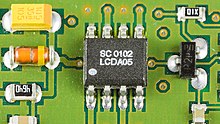Suppressor diode
Suppressor diodes , also known as transient voltage suppressors (TVS) , are diodes used to protect electronic circuits from brief voltage pulses. Such voltage pulses can occur in lines connected to the circuit due to switching processes in the network or near lightning strikes. The voltage reached for a short time can be sufficient to destroy semiconductor components in the circuit.
Suppressor diodes become conductive when a component-specific voltage threshold is exceeded. The current of the pulse is routed past the component to be protected by being connected in parallel. As a result, no destructive voltage can build up above the breakdown voltage of the suppressor. In the normal operating case, this diode behaves neutrally , apart from a low leakage current and an additional capacitance , which is particularly disruptive in high-frequency applications.
Types
The suppressor diode is available bidirectional and unidirectional. The latter is a further development of the Zener diode that has existed for decades at that time and has been on the market since the 1990s . New processes made it possible to drastically increase the switching speed every nanosecond and the discharge capacity in the breakdown direction, but at the expense of the breakdown voltage spread. The bidirectional suppressor diode is basically an anti-series connection of two unidirectional counterparts. While the latter conducts in the opposite direction like a normal diode from approx. 0.7 V, the bidirectional one protects in both current directions up to the breakdown voltage and is therefore also qualified for AC voltage applications.
Suppressor diodes are available as SMD , wired components , as arrays or as components with screw threads.
Component values
In the data sheet , the following key figures are usually given for the respective model:
- Maximum reverse standoff voltage : The voltage up to which the suppressor diode does not conduct significantly.
- Breakdown voltage ( breakdown voltage ): The voltage at which the suppressor diode goes into the conductive state.
- Terminal voltage ( clamping voltage ): The voltage at which the suppressor executes the maximum current.
- Peak Power ( Peak Pulse Power Dissipation ): The maximum power that can turn a short electrical pulse in the suppressor into heat without damaging them.
- Continuous power dissipation ( Steady State Power Dissipation ): The maximum electrical power that the suppressor diode can convert into heat without being damaged by excessively high temperatures.
- Leakage current ( leakage current ): The leakage current flowing through the suppressor at a given voltage in the reverse direction.
- Parasitic capacitance : The non-conductive diode behaves like a capacitor, which can affect fast circuits.
Applications
TVS diodes are primarily used to protect sensitive components and signal inputs from one-off, temporary overvoltages (transients) such as ESD events, interference from switching processes or thunderstorms. Occasionally with them induction over voltages such. B. of relay coils , against mass derived. The diodes cause as long as they are not thermally destroyed, unlike gas-filled surge arresters no voltage drop in the voltage to be protected and therefore after the response even without power interruption for use.
As an alternative to suppressor diodes, varistors are also used , especially for voltages from around 100 V. However, these have a slightly longer response time and a higher protection level. In addition, there are the gas discharge tubes already mentioned as coarse protection elements.
In the case of overvoltages that are unlimited in time, as can occur, for example, with defective power supplies , the TVS diode overheats, usually with thermal failure, which means that overvoltage protection is no longer necessary. A so-called clamping circuit must be provided to protect against overvoltages that are unlimited in time .
Unipolar suppressor diodes are increasingly replacing Zener diodes in the high power range because of their better properties and the significantly lower price and have almost displaced them from the market.
brand names
TVS diodes are marketed by various semiconductor manufacturers under protected brand names. Some famous brand names for TVS diodes are:
- Transil - brand name of ST Microelectronics
- Transzorb - brand name of Vishay , formerly General Instrument



